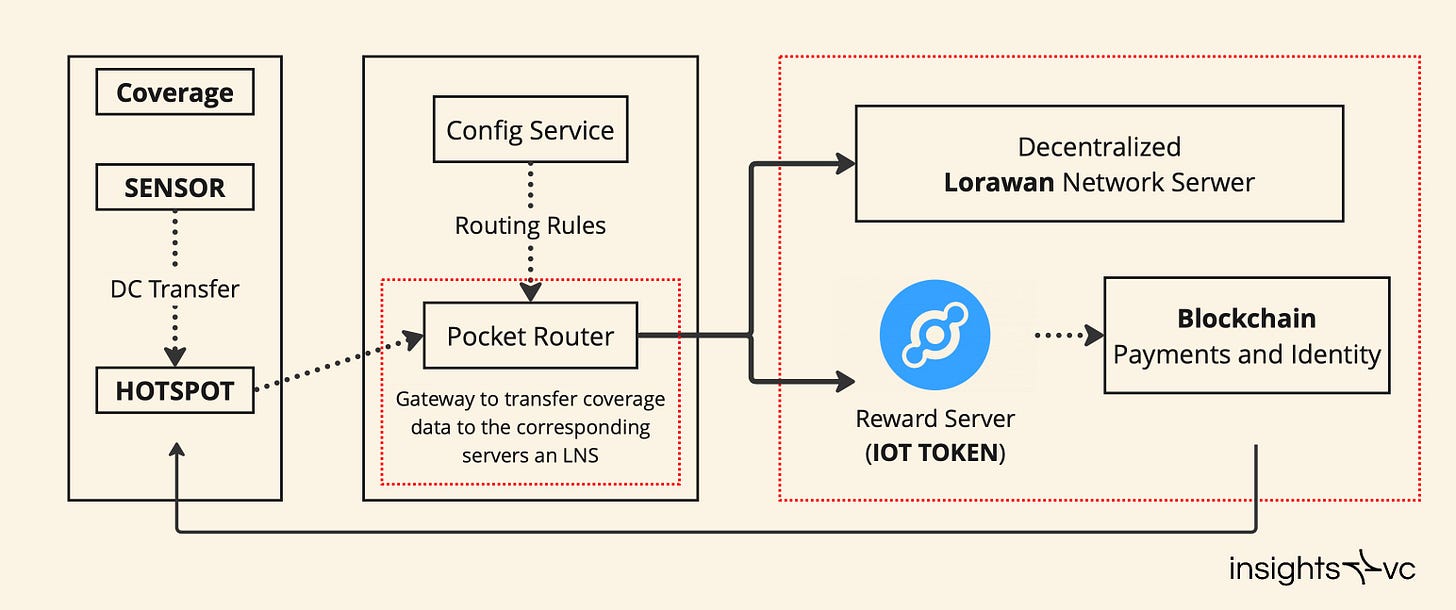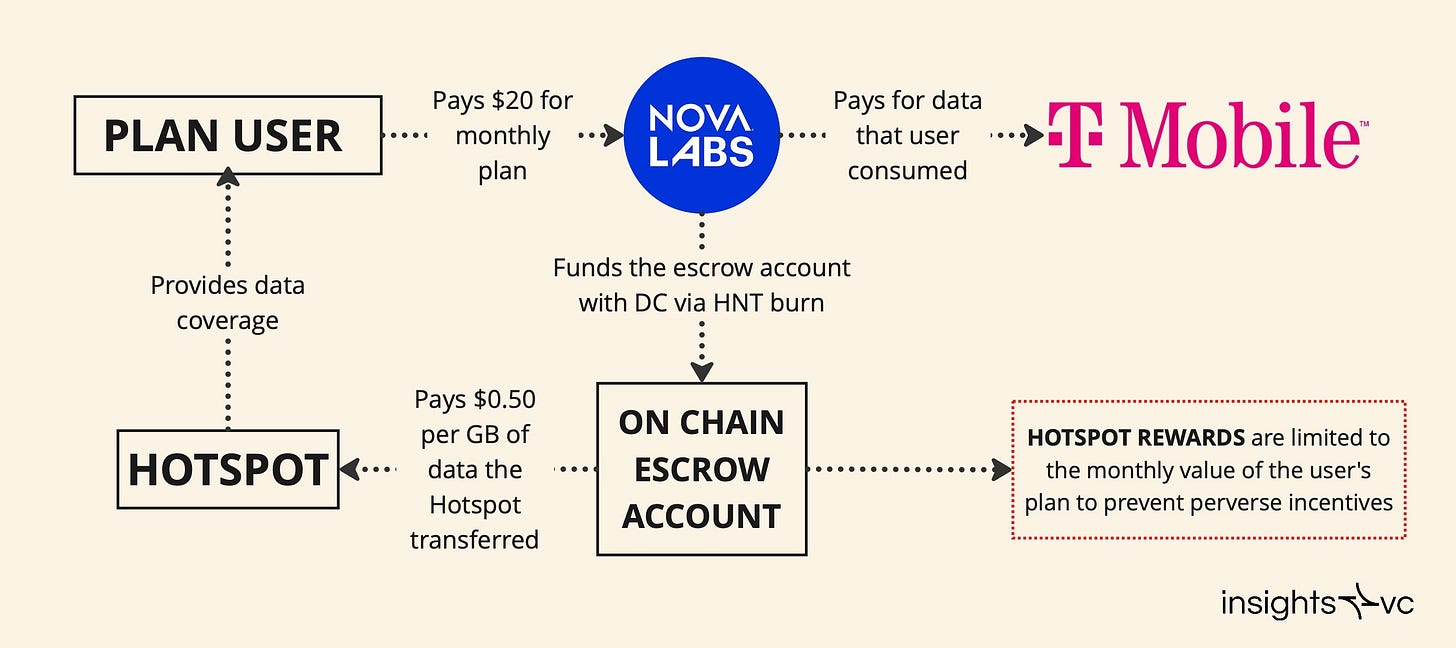Helium: Overview of Decentralized Network Evolution from IoT to 5G
Helium is frequently highlighted as a leading example of cryptocurrency's practical application. Founded in 2013 by Amir Haleem, Shawn Fanning (Co-Founder of Napster), and Sean Carey, Helium was created to build a decentralized wireless infrastructure supporting the Internet of Things (IoT). The goal was to make IoT connectivity more accessible through a community-driven network with economic incentives.
In 2019, Helium launched the Helium Hotspot, enabling users to provide wireless coverage for IoT devices using LongFi, a protocol combining LoRaWAN with the Helium blockchain. This allowed users to earn HNT tokens for contributing to network coverage. As the network expanded globally, attracting developers and users, Helium transitioned to the Solana blockchain to improve scalability and security. It also introduced subnetworks for different wireless technologies, like LoRaWAN and 5G, each with its own tokens (IOT and MOBILE) and Proof-of-Coverage incentives.
Initially, Helium aimed to partner with building owners for a LoRa gateway network. However, by 2017, the company shifted to incentivizing individuals with cryptocurrency to operate independent nodes, which provided payments and governance rights. A key milestone came in 2021 with a partnership with Dish Network, significantly expanding Helium's reach.
In 2022, Helium rebranded to Nova Labs Inc. and secured $200 million in funding. Despite facing scrutiny over alleged misrepresented partnerships, Helium continued its growth, migrating to the Solana blockchain and introducing new subnetworks to further its infrastructure, becoming one of the leading projects in the category of Decentralized Physical Infrastructure Networks (DePINs).
Helium Architecture
Pre-Solana Era
Helium initially launched its IoT network on a custom-built blockchain, providing LoRaWAN connectivity to IoT devices. Users could earn HNT tokens by deploying hotspots, rewarded based on the Proof-of-Coverage (PoC) mechanism, which verified the accuracy of hotspot locations and coverage. HNT was used to purchase Data Credits (DCs), a secondary token required for data transfer, priced at $0.0001 per 24 bytes.
Helium was designed as the first decentralized network protocol (DNP) for LoRaWAN. However, the network faced challenges when expanding to 5G, particularly in scalability and incentive alignment for subnetworks.
Transition to Solana
In January 2022, Helium transitioned to a subDAO framework on the Solana blockchain through the approval of Helium Improvement Proposals (HIPs) 51, 52, and 53. This restructuring allowed Helium to scale into an ecosystem of communication networks, with each subnetwork governed by its own subDAO.
Helium IoT: The original LoRaWAN network became the Helium IoT subDAO, issuing IOT tokens to reward network participants.
Helium Mobile: A new subDAO for 5G connectivity, where CBRS hotspot operators earn MOBILE tokens.
This setup allowed each subDAO to govern its protocol-specific details while being part of the broader Helium DAO structure, which oversees the ecosystem’s governance and onboarding of new DNPs.
Helium DAO Governance
Helium's governance model, introduced in HIP 51, enables scalable development and DNP-specific governance. SubDAOs operate independently, managing their own Proof-of-Coverage rules, data transfer pricing, and reward distributions through Decentralized Network Token (DNT) voting.
Core decisions affecting the entire Helium ecosystem are made through veHNT (vote-escrowed HNT) governance, with voting power proportional to the amount of HNT staked and the staking duration. HNT distributions to subDAOs are based on their utility scores, determined by factors like DCs burned and active devices.
Helium IoT
The Helium IoT subDAO manages the decentralized LoRaWAN network, allowing users to deploy hotspots and earn IOT tokens. Unlike traditional networks, Helium decentralizes LoRaWAN Network Servers (LNSs), enhancing security and distributing control.

The subDAO handles its own PoC, data transfer, and token emission processes, with governance conducted through veIOT, similar to veHNT.
Helium Mobile
Established by HIP 53 and launched in December 2023, the Helium Mobile subDAO supports a hybrid 5G network model, combining large-scale operators with individually-owned hotspots. Helium Mobile offers affordable, nationwide 5G connectivity, with hotspot operators earning MOBILE tokens based on their contributions to the network.

The subDAO incentivizes service providers to grow the network by offering MOBILE rewards, with Discovery Mapping enabling subscribers to help validate and improve network coverage, earning additional rewards in the process.
Core Team:
Founder & Chief Executive Officer: Amir Haleem
Chief Operating Officer: Frank Mong
Chief Technology Officer: Marc Nijdam
General Manager: Coco Tang
VP Business Development: Mark Phillips
Helium Funding Insights - Total Raised: $364.80M
Funding Rounds:
Seed: Date: 1 Nov 2013 | Amount Raised: $2.80M
Selected Investors: Slow Ventures, SV Angel, FirstMark, Digital Garage
Series A: Date: 9 Dec 2014 | Amount Raised: $16.00M
Selected Investors: Khosla Ventures (Lead), Slow Ventures, SV Angel, FirstMark, Digital Garage
Series B: Date: 25 Apr 2016 | Amount Raised: $20.00M
Selected Investors: GV Google Ventures (Lead), Khosla Ventures, FirstMark, Munich Re
Series C: Date: 15 Jun 2019 | Amount Raised: $15.00M
Selected Investors: Multicoin Capital (Lead), Union Square Ventures (Lead), Khosla Ventures (Lead), Slow Ventures, GV Google Ventures, SV Angel, +3 more
Undisclosed: Date: 10 Aug 2021 | Amount Raised: $111.00M
Selected Investors: Andreessen Horowitz (a16z) (Lead), Multicoin Capital, Ribbit Capital, 10T Fund, Alameda Research
Series D: Date: 19 Feb 2022 | Valuation: $1B | Amount Raised: $200.00M
Selected Investors: Andreessen Horowitz (a16z) (Lead), Tiger Global Management (Lead), Multicoin Capital, Pantera Capital, Ribbit Capital, GV Google Ventures, +10 more
Helium Network (HNT) Tokenomics Overview
HNT Address: hntyvp6yfm1hg25tn9wglqm12b8tqmcknkrdu1oxwux
The Helium Network operates with three distinct SPL tokens on the Solana blockchain: HNT, IOT, and MOBILE. HNT serves as the primary token across the Helium ecosystem, while IOT and MOBILE function as subDAO tokens, rewarding operators of the respective subnetworks.
Helium Network Token (HNT)
The Helium Network Token (HNT) is the central currency within the Helium ecosystem. It is allocated from the Helium DAO to various subDAOs based on their performance, measured by their utility scores. The token has three primary functions:
Purchasing Data Credits (DCs): HNT can be burned to acquire Data Credits (DCs), which are required for accessing subnetwork functionalities. The fixed price of a DC is $0.00001, and the amount of DCs received upon burning HNT is determined by the current market price of HNT.
Governance Staking: HNT holders can stake their tokens to receive veHNT, a governance token granting voting power within the Helium DAO. This mechanism enables HNT holders to participate in the decision-making process of the overarching Helium Network, particularly in voting on Helium Improvement Proposals (HIPs).
Redeemability for SubDAO Tokens: HNT can be exchanged for IOT or MOBILE tokens, which are used to reward participants operating within the IoT and Mobile subnetworks, respectively.

Economic Considerations:
Max Supply and Halving Schedule: The maximum supply of HNT was established at 223 million tokens, with a halving schedule every two years. As of August 2024, the total supply is 168.9 million HNT, with the adjusted maximum supply reduced to 213 million HNT due to deflationary burns.
Token Unlock and Vesting: A total of 7 million HNT is allocated to Founders and Investors, representing 31% of newly minted tokens annually, decreasing by 1% each year until reaching a cap of 15%. Additional allocations include 13 million HNT for consensus purposes (6% annually), 55 million HNT for Proof of Coverage (28% annually, decreasing by 1.5% yearly), and 78 million HNT for Data Transfer (30% annually, increasing by 2.5% yearly, capped at 79%).
Burn and Mint Equilibrium: HNT operates under a burn-and-mint equilibrium model, ensuring that the token supply remains aligned with network usage. The burning of HNT to purchase DCs naturally reduces the circulating supply, while new tokens are minted based on network demand.
Net Emissions: Introduced in HIP 20, the Net Emissions mechanism ensures ongoing incentives for network operators by monitoring HNT burn rates and adjusting the supply as necessary. The daily emission cap is set at 1,643.52 HNT, ensuring consistent rewards for subnetworks.
Data Credits (DCs)
Data Credits (DCs) are a non-transferable currency used within the Helium Network to pay for data transfer and other network-related fees. DCs are exclusively obtained by burning HNT and are priced at a fixed rate of $0.00001 per DC. Their utility varies slightly between the IoT and Mobile subnetworks:
IoT Network: DCs are used to pay for data transfer, calculated in 24-byte increments, as well as for device onboarding ($40) and location assertion ($10) fees.
Mobile Network: In the Mobile Network, DCs pay for data transfer at a rate of $0.50 per gigabyte (50,000 DCs) and cover fees such as CBRS onboarding ($40) and CBRS location assertion ($10).
SubDAO Network Tokens: IOT and MOBILE
Under the Helium DAO framework, subDAO tokens like IOT and MOBILE are created to manage governance and rewards within their respective subnetworks.
IOT Token (Address: iotEVVZLEywoTn1QdwNPddxPWszn3zFhEot3MfL9fns): IOT is the native token of the Helium IoT Network, rewarded to operators for Proof of Coverage (PoC) and data transfer activities. Governance within the IoT subDAO is facilitated by veIOT, which is awarded to users staking IOT tokens.
MOBILE Token (Address: mb1eu7TzEc71KxDpsmsKoucSSuuoGLv1drys1oP2jh6): MOBILE serves the Helium Mobile Network, rewarding participants such as PoC oracles, 5G-CBRS, and WiFi hotspot operators. Like the IOT token, MOBILE can be exchanged for HNT or staked to receive veMOBILE, granting governance rights within the Mobile subDAO.
Key Metrics (August 22, 2024)


Latest Helium Improvement Proposal (Completed: Aug 21, 2024, 10:00 PM) - HIP 128:
HIP 128 proposes the creation of a new subnetwork within the Helium ecosystem called ENERGY. This subnetwork is designed to reward users who contribute to solar power production and battery energy storage. It aims to collect data from and control connected solar and battery resources, creating a virtual power plant to enhance grid stability and energy management.
Key Proposal Points:
Creation of Virtual Power Plants (VPP) by linking distributed energy resources (DERs).
Issuance of 250 billion ENERGY tokens, with 60 billion allocated to investors and 190 billion reserved for network rewards.
Compatible IoT hotspots can join the ENERGY network through a required software upgrade.
Conclusion
Helium is actively cultivating an ecosystem of decentralized wireless and Decentralized Physical Infrastructure Networks (DePINs), already supporting diverse networks such as IoT and 5G telecommunications. The Helium Network Token (HNT) plays a central role in this ecosystem, capturing demand-side revenue through Data Credits, facilitating governance participation, and serving as a reward mechanism within the subDAO framework.
The network’s subDAO structure enables the creation of subnetworks, each with its own native token. Since the launch of Helium Mobile in December 2023, the platform has experienced rapid growth, now generating approximately 90% of the network’s revenue. Helium's growth strategy focuses on building partnerships with hardware manufacturers and telecom providers, while strategically shifting relationships with traditional telecom companies like T-Mobile and Telefónica. This approach lays the groundwork for DePINs to join Helium as a network of networks.
Expanding the utility and quality of its existing networks remains a priority for Helium, alongside its commitment to onboarding new wireless and DePIN networks. This strategy will be pivotal in driving Helium's growth and enhancing Solana’s reputation as a platform for decentralized physical infrastructure and resource protocols.
Links
Sources
Risk Disclaimer:
insights4.vc and its newsletter provide research and information for educational purposes only and should not be taken as any form of professional advice. We do not advocate for any investment actions, including buying, selling, or holding digital assets.
The content reflects only the writer's views anda not financial advice. Please conduct your own due diligence before engaging with cryptocurrencies, DeFi, NFTs, Web 3 or related technologies, as they carry high risks and values can fluctuate significantly.








DePINs like Helium stands out with its real-world utility